The original or "true" myrtle, Myrtus communis L., named from the ancient Greek myrtos, is a Mediterranean shrub or small tree, famous for its uplifting aromatic qualities. Many additional plants over the millennia have been called myrtles. For example:
|
| Blue Myrtle: Ceanothus thyrsiflorus |
| Bog Myrtle: Myrica Gale |
| Cape Myrtle: Myrsine africana |
| Crape Myrtle: Lagerstrœmia indica |
| Downy Myrtle: Rhodomyrtus tomentosa |
| Florida Myrtle: Myrcianthes fragrans |
| Fringe Myrtle: Calytrix spp. |
| Gum Myrtle: Angophora spp. |
| Heath Myrtle: Baeckea spp. and Thryptomene spp. |
| Honey Myrtle: Melaleuca spp. |
| Jew's Myrtle: Ruscus aculeatus |
| Juniper Myrtle: Agonis spp. |
| New Zealand Myrtle: Lophomyrtus spp. |
| Oregon Myrtle: Umbellularia californica |
| Running Myrtle: Vinca minor |
| Sand Myrtle: Leiophyllum buxifolium |
| Scent Myrtle: Darwinia spp. |
| Sea Myrtle: Baccharis halmifolia |
| Snow Myrtle: Calytrix spp. |
| Swan River Myrtle: Hypocalymma robustum |
| Tasmanian Myrtle: Nothofagus Cunninghamii |
| Wax Myrtle: Myrica spp. |
| White Myrtle: Rhodamnia argentea |
Willow Myrtle: Agonis spp.
|
| The Orange-bark Myrtle, also called Tree Myrtle and Chilean Myrtle, is from temperate Chile and western Argentina. It is a versatile, handsome plant with edible berries, and is still too little known in Seattle. So here I write about it. . . . |
| Besides its aforementioned English names, one can add Temu Tree. And in Spanish it is Palo Colorado. The most common name in Chile is Arráyan; another is Collimamül (meaning orange wood). The scientific name Luma is derived from a Mapuche name. Over the years this species has been classified variously by botanists; the first scientific description was by Augustin Pyramus de Candolle in 1828, as Eugenia apiculata. |
| It was introduced to cultivation in the northern hemisphere in 1843-44, when William Lobb sent seeds to England. It was cultivated in California by 1897, and was being sold in nurseries there by 1909 if not earlier. In Seattle it has been grown since at least 1988 --I had one by then, if not a year or two earlier. However, most specimens seen in Seattle date from the 1990s or later. |
| In the wild Orange-bark Myrtle is enormously variable, and can be a shrub or a tree up to 80 feet tall (25 m), as old as 600 years. Trunks can measure more than 4 feet (1.2 m) thick. It grows from sea level to 2,300 feet (700 m) in elevation. A famous pure stand grows in the National Park Los Arrayanes. |
| People treasure it as an ornamental because it is so attractive. The leaves are evergreen, petite, dark green, setting off puffy white flowers of pleasing fragrance, that give rise to shiny black berries. If this was all, it would suffice. Yet moreover, the bark is gorgeous orange flaking away to reveal patches of white, and the berries are edible, the leaves aromatic. The only things I dislike are that it is borderline cold-hardy in Seattle, and it can reseed weedily. |
| For an account of its cold-hardiness in Ireland and England, I here supply a quote from Alan Mitchell's Gardener's Book of Trees (1981; page 107): "This tree from South America runs wild in the gardens of Counties Cork and Kerry [Ireland] and makes a tree to 15 m [50 feet] in Devon, Cornwall and Argyll, but further east and even along the south coast, it is progressively smaller and struggling until only a bush in Kent and not reliably hardy east of Dorset." |
| The leaves, borne on fuzzy twigs, are in opposite pairs on very short stalks, measure from about a half-inch to almost 2 inches long, terminating in a raspy little point (hence the name apiculata). When crushed they exude a sweet spicy aroma. In June or July masses of flowers appear; a few persist into autumn. These are about three-fourths of an inch wide, consisting of 4 cupped white petals around many stamens, the latter pink. By fall the berries are shiny deepest dark purple-black, juicy, and ripe for eating. They are about the size of blueberries. Isolated specimens can still set heavy crops. |
| The plant is usually sold as a shrub. It can grow in full blasting sun or considerable shade. In the sun it will be densely leafy; more lanky in shade. Summer watering in Seattle is highly desirable, though not necessary for mere survival. Irrigation will encourage the sprouting of its seeds. Orange-bark Myrtle is amenable to pruning, and its lowest branches ought to be gradually pruned off to reveal the warm cinnamon-orange bark. The tallest specimens in Seattle so far are around 15 feet. In Ireland the tallest is about 65 feet. Because severe winter cold will kill the leaves and twigs, it may be best considered a shrub. Also, if it grows too tall, people cannot reach the edible berries. Fanciers of bonsai and topiary will also find this plant worth playing around with. |
| Besides its good looks and edible berries, Orange-bark Myrtle has been used in Chilean folk medicine for many ills, and its hard wood is made into tool handles, furniture and the like. |
| A cultivar featuring gold-variegated foliage originated in Ireland. Roy Lancaster reported that in October 1982 that the original specimen, dating from pre-1970, was about 6 m tall [20 feet] at Valentia Island, County Kerry. This clone is sold as 'Glanleam Gold' and is in commerce locally. |
| There are from 1 to 3 other species of Luma, yet as far as I have been able to learn their bark is not so lovely, so they are less interesting prospects for the gardener. |
Various mail-order nurseries stock Orange-bark Myrtle, its cultivars and cousins.
Back |
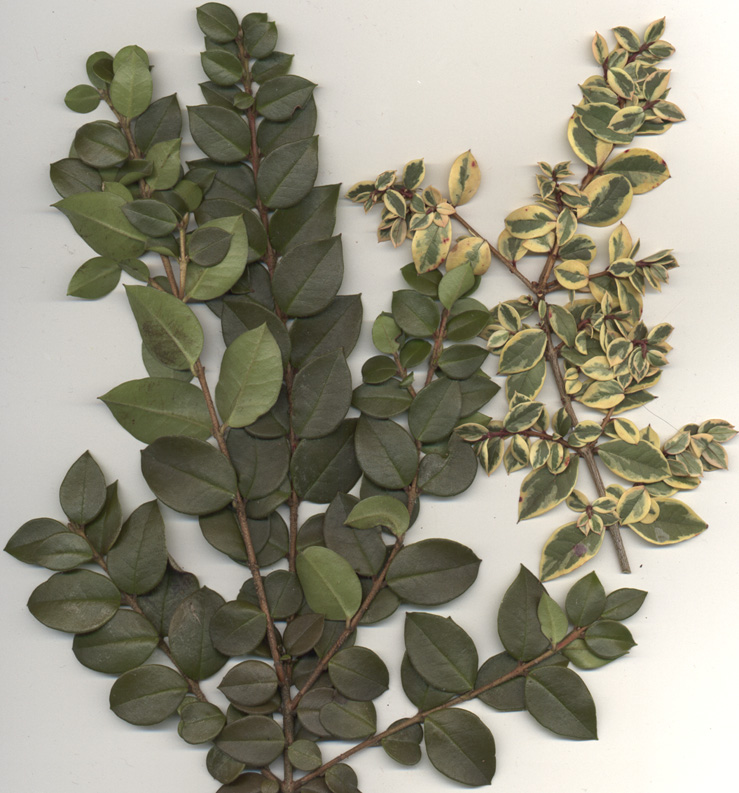
scan by ALJ |
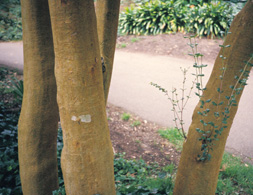
Luma in San Francisco photo by ALJ |
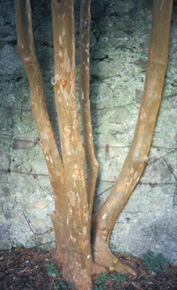
Luma in Ireland photo by ALJ |
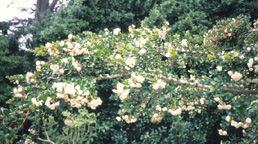
Luma flowers photo by ALJ |
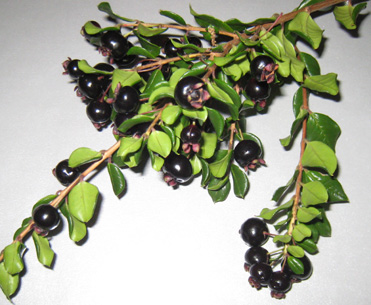
Luma berries photo by ALJ |

